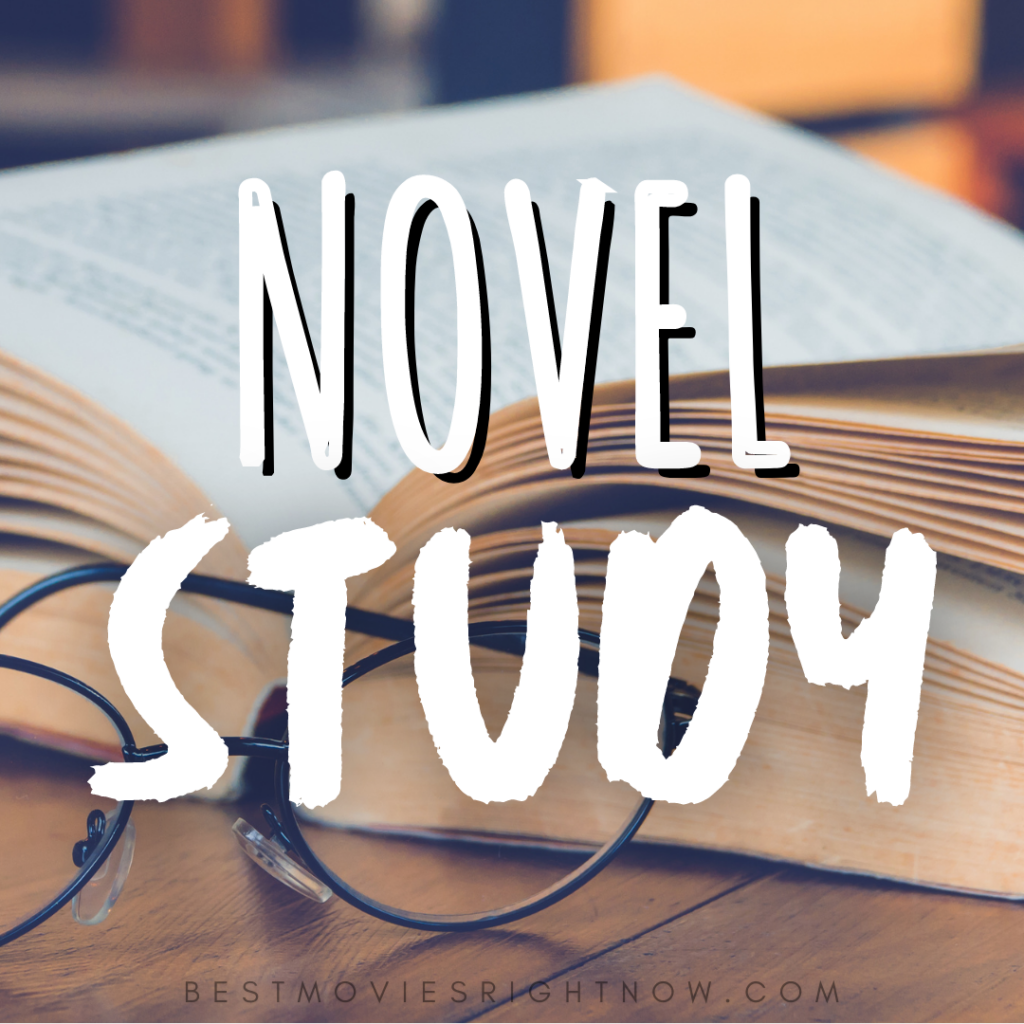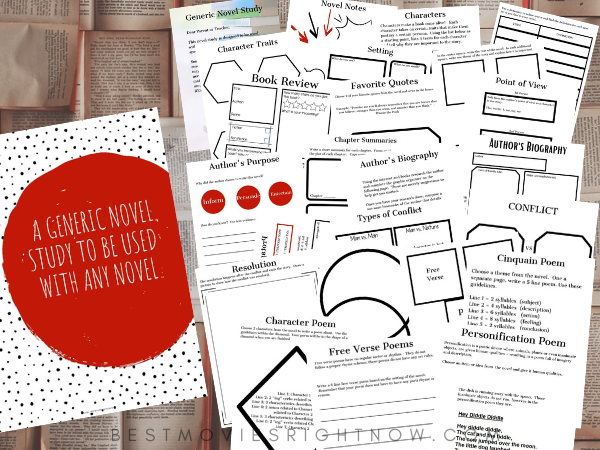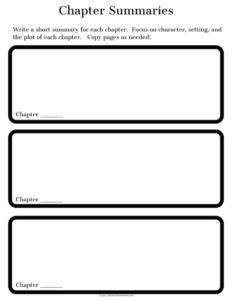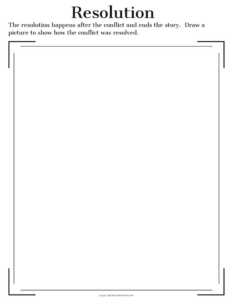This is one of many studies that show the advantages of students reading novels; others claim that reading fiction teaches us a lot about society and social skills. Here is a Novel Study that you can use to encourage your kids or yourself to grab and read a book with appreciate Awesome Books that Became Movies.

About This Generic Novel Study
Dear Parent or Teacher,
This novel study is designed to be used with any novel. It is not geared toward any specific genre or age level.
Some pages may not fit the novel you are reading and some pages may need to be duplicated to fit your needs. Please do what you need to do to make this work for you and your student(s). But above all, ENJOY READING!
In this comprehensive study, you'll find 24 differentiated activities for ANY novel unit or film study.
This resource is perfect if you're looking for a variety of activities that are engaging and demonstrate comprehension WITHOUT multiple-choice tests.
You'll notice that this open-ended project is incredibly flexible allowing your students to think creatively and work through their book in a natural way.
This 26-page novel or movie study includes:
- Novel Notes
- Definitions
- Character Traits
- Setting
- Themes
- Book Review
- Favorite Quotes
- Point of View
-Author's Point of View - Author's Purpose
- Chapter Summaries
- Author's Biography (two pages)
- Protagonist vs. Antagonist
- Types of Conflict
- Conflict
- Resolution
- Character Comparison
- Poetry & Novels
- Cinquain Poem
- Character Poem
- Personification Poem
- Free Verse Poems
Click here to download this printable.
Generic Novel Study
Novel Notes
Use these graphics to mark pages or passages in the book you're reading. Or, as a scribble page they can jot notes down when they are reading chapters.
Click here to download this printable.
Definitions
Use a dictionary or online source and find the definition for each new term you find in your novel.
Click here to download this printable.
Characters
Characters make a book come alive! Each character takes on certain traits that make them portray a certain persona. Using the list below as a starting point lists 4 traits for each character and tell why they are important to the story.
Please Note: Other traits can be used. These are not the correct answers.
Click here to download this printable.
Character Traits
Everyone has both positive and negative personality traits. Character traits can be found in fictional characters as well. Character traits are frequently expressed using descriptive adjectives such as patient, unfaithful, or jealous.
Click here to download this printable.
Setting
In the center square, write the title of the novel. In each additional square, write one theme of the story and explain how it is important.
Click here to download this printable.
Themes
A theme is a central concept or underlying meaning explored by a writer in a novel, short story, or other literary work. A story's theme can be expressed through characters, setting, dialogue, plot, or a combination of all of these elements.
Click here to download this printable.

Book Review
A book review serves as a guide for prospective readers. A review summarizes the author's qualifications and main points in a concise manner, often using examples from the text.
A review also expresses an opinion on whether or not the author is successful in persuading readers of his or her points.
Click here to download this printable.
Favorite Quotes
Choose 2 of your favorite quotes from the novel and write in the boxes.
Example: “Promise me you’ll always remember that you are braver than you believe, stronger than you seem, and smarter than you think.” Winnie the Pooh
Click here to download this printable.
Point of View
1st Person
Told from the author's point of view as a character in the story.
Clue words: I, me, my, we
2nd Person
As a character in the story, the reader is immersed in the narrative. The narrator describes what “you” do and takes you into your own mind and past.

3rd Person
The author exists outside the story.
Omniscient: the author knows about all the character's feelings and thoughts.
Limited Omniscient: the author knows about the thoughts and feelings of only one character
Click here to download this printable.
Author's Purpose
The reason for or purpose behind an author's writing is referred to as his purpose. An author's goal may be to entertain the reader, persuade the reader, inform the reader, or satirize a situation.
- Why did the author choose to write this novel?
- How do you know? Use text evidence.
Click here to download this printable.
Chapter Summaries
A summary is a concise explanation of a work's main ideas and supporting details. While reading the chapter, consider the “who, what, when, where, why, and how” to decide which details to include in the summary.
Write a short summary for each chapter. Focus on the character, setting, and the plot of each chapter. Copy pages as needed.
Click here to download this printable.
Author's Biography
Using the internet and books research the author and complete the graphic organizer on the following page. These are merely suggestions to help get you started.
Once you have your research done, compose a one-page biography of the author that details what you have discovered about them.
Click here to download this printable.
Protagonist vs. Antagonist
Directions: Name the protagonist(s) and antagonist(s)and list 3-5 character traits for each. List similarities between the two in the middle.
Protagonist: The main character of the story and the good guy/girl or hero.
Antagonist: The opposer of the main character or the bad guy/girl or villain.
Remember, an antagonist isn’t always obvious and may not be evil!
Click here to download this printable.
Types of Conflict
It is important to figure the type of conflict in a story to drive the narrative forward.
Man vs. Man: The character has a problem with another character.
Man vs. Nature: The character is lost in the woods and needs to survive until help arrives.
Man vs. Self: The character is struggling with something within him/herself. Not sure about how to handle a situation.
Man vs. Society: Character is dealing with unfairness of society. Struggles with laws, beliefs or values of a group.
Click here to download this printable.
Conflict
Conflict is essential in any story because it creates tension and compels the plot forward. Different approaches to conflict resolution can benefit different types of conflict, such as task conflict, relationship conflict, and value conflict.
Click here to download this printable.
Resolution
The resolution happens after the conflict and ends the story. Draw a picture to show how the conflict was resolved.
Compare yourself to one of the characters in the book. Make sure you list both similarities and differences.
Click here to download this printable.
Cinquain Poem
Cinquains are only five lines long and contain only a few words on each line, making them simple to write.
Choose a theme from the novel. On a separate page, write a 5 line poem. Use these guidelines.
Line 1 = 2 syllables (subject) Line 2 = 4 syllables (description) Line 3 = 6 syllables (action) Line 4 = 8 syllables (feeling) Line 5 = 2 syllables (conclusion)
Example from the internet:
Dogs Furry, Friendly Barking, Fetching, Playing Friends When you need them
Pets
Click here to download this printable.
Character Poem
Character poems, also known as persona poetry, are a type of poetry in which the author takes on the persona of someone other than themselves.
Click here to download this printable.

Personification Poem
Personification is a poetic device where animals, plants, or even inanimate objects, are given human qualities – resulting in a poem full of imagery and description.
Choose an item or idea from the novel and give it human qualities.
The dish is running away with the spoon. These inanimate objects do not run, however, in the personification poem they are.
Click here to download this printable.
Free Verse Poems
Poetry that lacks a consistent rhyme scheme, metrical pattern, or musical form is known as free verse poetry. Free verse poems have no regular meter or rhythm.
They do not follow a proper rhyme scheme; these poems do not have any set rules.
Write a 6-line free verse poem based on the setting of the novel. Remember that your poem does not have to have any particular rhyme or reason.
Click here to download this printable.

If you enjoyed this, I have a monthly membership for parents and educators that want to teach or supplement lessons with shows and movies.

“I absolutely love sharing movies with my kids as a way to teach them valuable lessons. It's like this awesome bonding experience where we all snuggle up on the couch with some popcorn, and I get to see their little faces light up with curiosity. Whether it's a classic with timeless morals or a new animated flick with hidden gems of wisdom, it's a fantastic way to impart important life lessons in a fun and engaging way. Plus, the post-movie discussions are priceless – hearing their take on the characters and the story adds a whole new dimension to our family time.” –a Homeschooling parent
With Homeschooling with Shows and Movies membership, you will get resources every month, including:
- List of This Month’s Suggested Themes
- List of Monthly Observances
- List Of Movies for Unit Study
- Unit Study Resource
- Seasonal Activities (minimum of three)
- (BONUSES) Resources for you, the teacher
These resources are worth it if you'd like to easily incorporate shows and movies into your homeschooling.
Related Posts:
- Book vs. Movie Review
- List of Nicholas Sparks Books
- Why You Should Watch Movies Based on Classic Novels
- Movie Review Lapbook
- 11 Awesome Books That Became Movies
- 20 Books to Read Aloud and Watch the Movie
- Books, Reviews & Challenges

- 18 Upcoming YA Books Turned Movies - April 1, 2024
- 30 Best Rom Coms From the 80s & 90s - March 29, 2024
- The Best Shows to Watch for a US States Unit Study - March 26, 2024



















